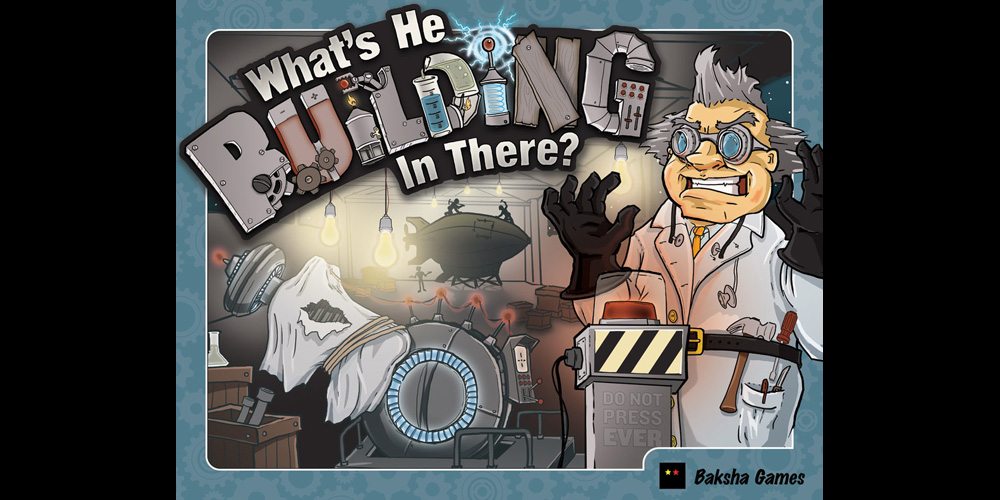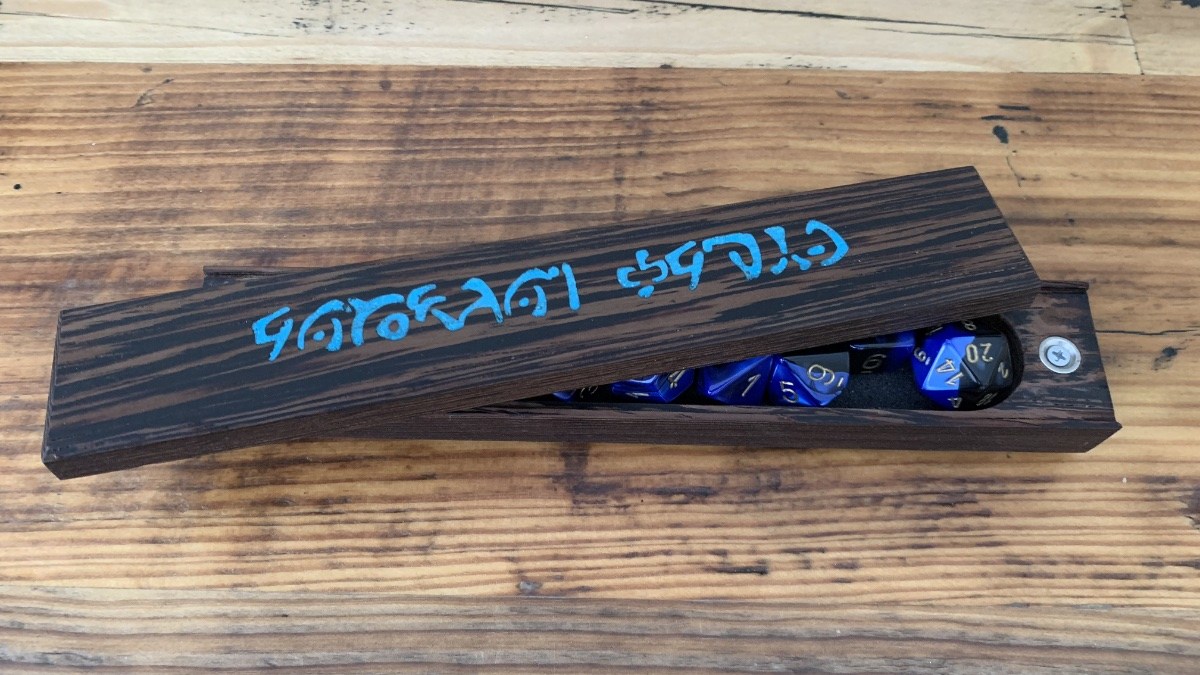It’s the late 1800s. You’ve got your Evil Doctorate and you’re ready to start working on your Doomsday Machine. Obviously, London is the place to be—plenty of henchmen to be hired, resources to acquire, not to mention a great place to move up in society. There are other evil doctors there, of course, but they don’t know the brilliant ideas you have up your sleeve. You can hear them asking: “What’s He Building in There?”
At a glance: What’s He Building in There? is a worker-placement game for 2 to 6 players, ages 12 and up, and takes roughly 30 minutes per player. It retails for $49.95. I think the age recommendation is about right—the biggest thing may be whether your kids have the patience for the game, since a full group of 6 will take about 3 hours until everyone is familiar enough with the game to speed things up.

Components:
- 14 Workshop cards
- 12 Black Market cards
- 48 Intermediate Invention cards
- 12 Direct-Effect Invention cards
- 175 small Resource cards
- 6 Turn Summary cards
- 7 Doomsday Machines
- 7 Escape Plans
- 30 Wooden Cubes (5 each in 6 colors)
- 6 Evil Doctor pawns (1 each in 6 colors)
- 18 Henchman pawns (3 each in 6 colors)
- 2 white cylinders (starting player token and round marker token)
- 49 Money tokens
- 1 Game Board
The first thing you’ll notice when setting up the game is that there is a lot of stuff here. The game board is nearly three feet wide, and the invention cards are all slightly larger than what I’m accustomed to. The resource cards are small, but there are 12 different types that you’ll need to sort into piles. So be prepared with a lot of table space.
The Evil Doctor pawns are large wooden silhouettes of the mad scientist you see on the front cover, and they’re also extra big. The henchmen are more standard-sized wooden pawns.
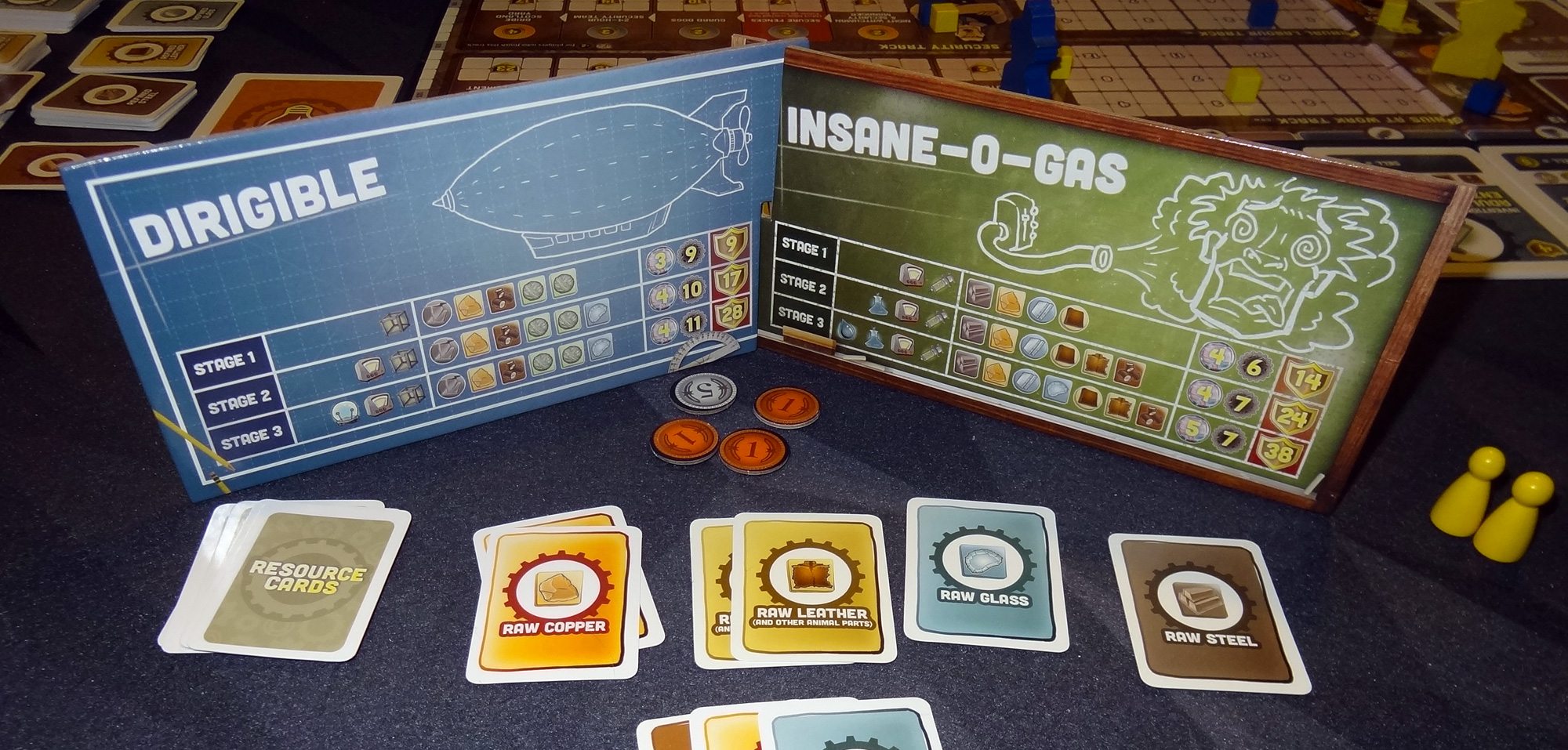
The Doomsday Machines and Escape Plans are boards that have notches so they slot together. Each one has icons indicating the types of inventions and resources you’ll need to build its three stages, and they also serve as a player screen to hide your money and resources from the other players. (However, I should note that during play we frequently found ourselves tipping the screens at an angle so we could review the chart of costs.)
There are some illustrations here and there that are fun and in keeping with the theme of the game, but most of the cards and board are simply spaces with icons—functional but not particularly exciting. For many of the tracks on the board, there are large spaces big enough to fit six cubes, since theoretically all the players could be on the same space at any given time. However, I do think that (and the oversize cards) make the board a bit larger than it needs to be—you could just as easily stack the cubes in a smaller space.

The resources are identified by a background color, an icon, and a shape: raw resources are square, and refined resources are circles. However, it can be a little confusing because the raw cloth is a ball of yarn inside a square border—it can easily be confused for a circle.
How to play
You can view the rules of the game at the Baksha Games website.
The goal of the game is to score the most points in 15 rounds—you must complete your Doomsday Machine and Escape Plan to win, but you also score points through inventions, exotic pets, and other means.
Each player draws a Doomsday Machine and Escape Plan randomly and keeps them secret from other players. Each player also takes the pawns and cubes of their color, and some amount of money (depending on who is starting player, who gets the starting player token).
The resource cards are sorted by type and placed in piles next to the board, and the inventions are all laid out in stacks along the edge of the board where indicated. Intermediate inventions are stacked so that the top card awards points (and requires Genius-at-Work resources to build). The Direct-Effect inventions are shuffled and four are randomly placed face-up along the edge of the board.

The Workshop cards and Black Market cards are shuffled separately into two decks and place near the board. Deal out a number of Workshop cards equal to the number of players, plus four Black Market cards, placing them in their spots on the board. The round marker is placed on Round 1.
Each round has the following phases:
- Place workers (doctors and henchmen)
- Resolve workers
- Invent
- Pay Rent
- Replace cards
Place workers: In turn order, you place workers on the board. Doctors go in orange spaces, henchmen go in blue-grey spaces, and either can go in the orange-and-blue spaces. In general, each space can only hold one pawn. You can go to the Workshop spaces to collect raw materials or refine materials. The Black Market spaces may also let you collect or refine resources, but at a price; there are also Black Market spaces for trading resources, collecting gold, and taking the first player token. In the center of the board are tracks for building up Genius-At-Work (GAW) and Manual Labour, two intangible resources needed to invent and build things. These tracks do have spaces for multiple players, though the first person on each track gets a bonus.
There are also three tracks that are primarily for scoring: the Social track, Security track, and Exotic Pets track. Basically these represent your attempts to move up in society, beef up security, and collect the strangest pets.

Resolve workers: After everyone has placed all of their pawns, you resolve them in the order marked on the board (roughly left to right). At the Workshops, the player who was first on the card gets to decide whether that workshop is providing raw materials or refining materials that round. Both doctors and henchmen can be in a workshop, with the doctor getting a slight bonus. In the scoring tracks, you’ll generally have to pay money in order to move to the next level.
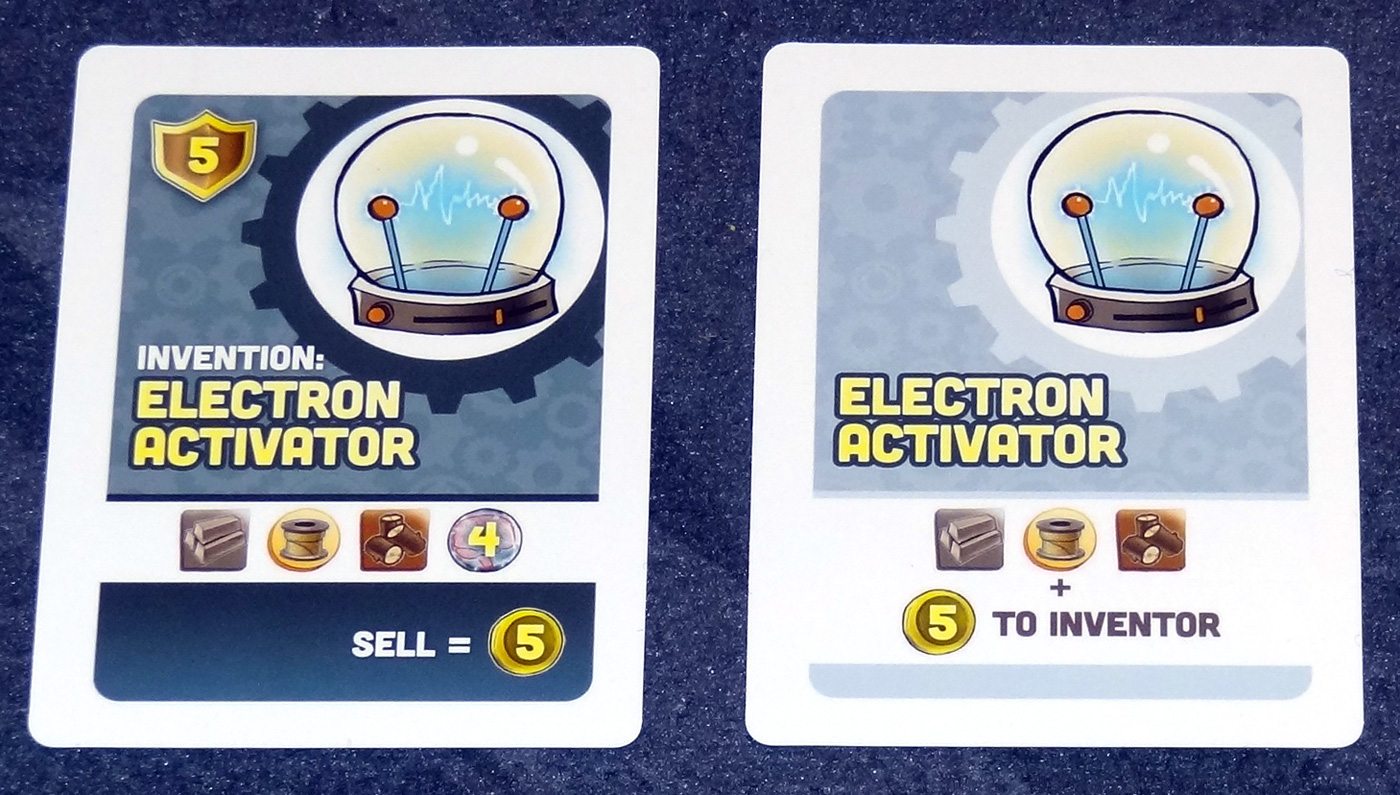
Invent: Each player (in turn order) may build one invention by turning in the required resources and taking the invention card. The Intermediate Inventions are used toward your Doomsday Machine and Escape Plan—for instance, to build stage 1 of the Insane-O-Gas, you’ll need the Adulterative Enzyme and the Circuit Transmogrifier (along with various resources). The first person to build an Intermediate Invention will get points, but has to spend GAW resources. After that, other players pay gold to the original inventor to build their own. Direct-Effect inventions are all unique; they award points and give special abilities to the player who builds them.
Pay Rent: Starting in Round 5, if you haven’t reached the “Real Estate” point on the Social Track, then you must pay 1 coin in rent to the supply. Hey, at least your parents aren’t charging you much for living in their basement.
Replace Cards: The Workshop and Black Market cards are removed and new ones are dealt from the deck. (If a deck is empty, reshuffle.) Also, new Direct-Effect Inventions are drawn to replace any that were built, and the round marker moves.

After the end of 15 rounds, players reveal their Doomsday Machines and Escape Plans. You must have built up enough resources (including GAW and Manual Labour) to build at least Stage 1 of each device, or you’re laughed out of the evil doctor guild (or get caught by the angry mobs). The higher the stage you build, the more points it’s worth. You also get points for your other inventions, and the social, security, and exotic pets tracks. Highest score wins—ties go to the payer with the most inventions.
The Verdict
I’d heard about What’s He Building in There? but had missed the Kickstarter campaign and didn’t actually see the game myself until Gen Con this year. (Yes, it’s November already and I’m still writing up Gen Con games. There were a lot.) Although it had been successfully funded in 2013, the game wasn’t quite ready yet at Gen Con 2013, so this year was its debut.
What’s He Building in There? was designed by Sean Scott Garrity, and thematically it follows his previous game Good Help, which also followed a group of evil doctors trying to find reliable henchmen to build their village-destroying monsters.
I’ve been looking for a good mad scientist game for a while. Years ago I picked a copy of Mwahahaha!, which had great artwork and a lot of humor, but just didn’t have very good gameplay. And last year I was rooting for Stormy Weather, which sadly didn’t reach its funding on Kickstarter. What’s He Building in There? manages to mix in some of the humor of mad scientist tropes with solid gameplay, and finally scratches that itch for me.
It’s not perfect, so I’ll get my gripes out of the way first. I’ve already mentioned that the game is just big. That in itself isn’t reason to avoid it—at least the box is sized properly for the components rather than being full of empty space—but it’s just sort of funny that everything is oversized except the resource cards, which are those tiny mini-cards that are hard to handle. Thankfully, you don’t ever have to shuffle them.
Apparently there weren’t any female evil geniuses in London in the 1800s—or at least you wouldn’t know it from the title. Not a huge deal, and “What’s He or She Building in There?” wouldn’t be a great title, but the game itself isn’t gender-specific, just the title.
My primary complaint is simply the length of the game. I’d love to have What’s He Building in There? be about an hour or so, but that half-hour-per-player estimate makes me balk at trying a full 6-player game. The reason it takes so long is that you’re playing 15 rounds, and everyone is making decisions about where to place four workers each round—if you’ve got players prone to analysis paralysis, expect it to take even longer. But if you shortened the game, you wouldn’t have enough time to collect all the resources needed to build the devices. Reducing the overall requirements for the devices would, I think, change the flow of the game. So, like it or not, What’s He Building in There? is just stuck being a longer game—it’s not a deal-breaker for me, but may scare off some players from trying it.
What I like about the game, though, is that it captures the theme pretty well. There are things the doctor can do that henchmen can’t, and vice versa. Your doctor, for instance, isn’t going to lift a finger to do the actual building of the devices—that’s what henchmen are for, right? But the henchmen can’t do the inventive thinking that’s needed to come up with the crazy inventions—that’s where the GAW comes in. I also love the various ways you climb the social ladder and improve your security (though I was slightly disappointed that it didn’t include sharks with head-mounted lasers).
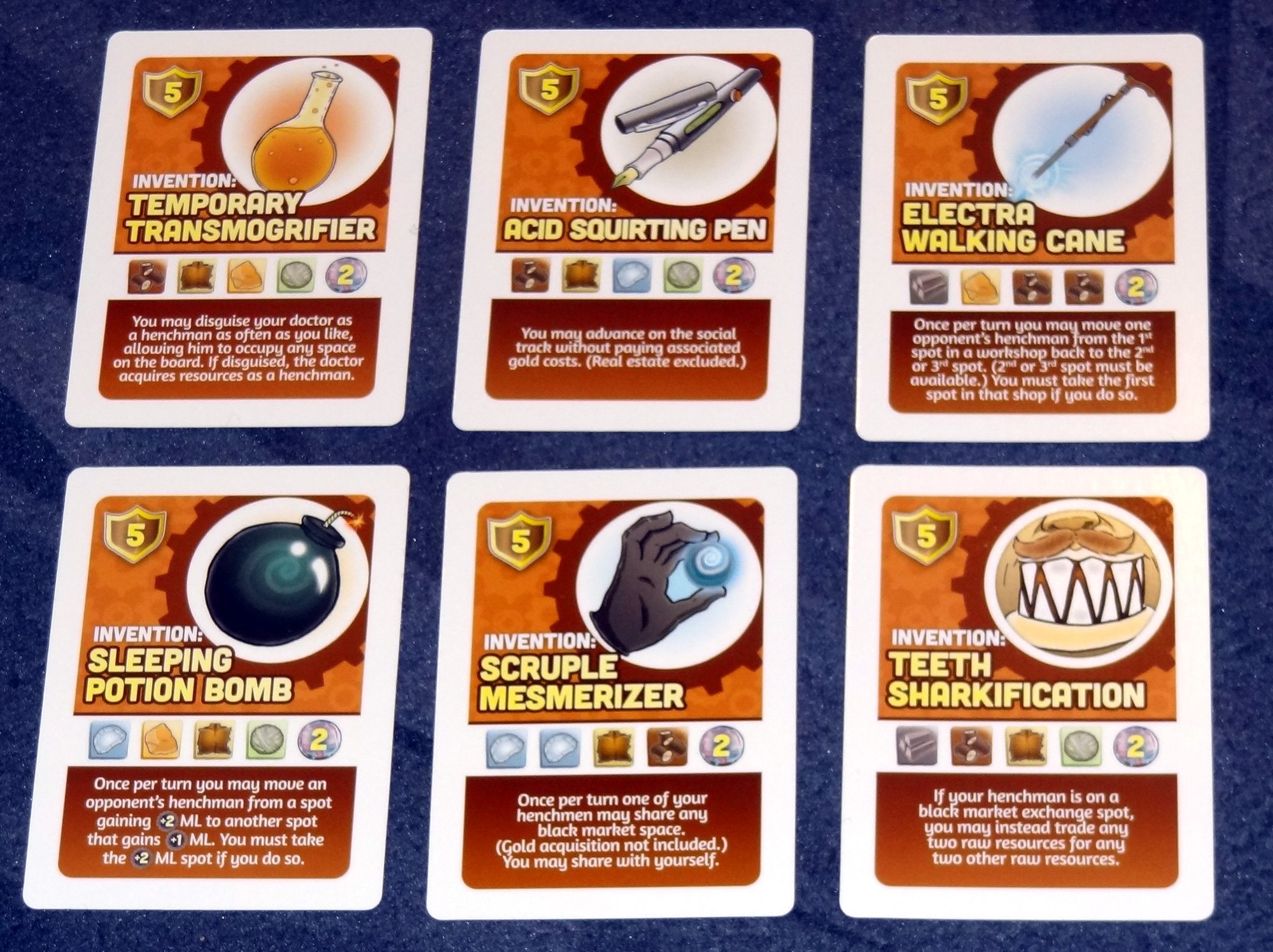
Like most worker placement games, much of the interaction in the game comes in how you place your workers in order to get the spots you want before they’re taken. Many of the spaces have bonuses for the first player there: Workshops allow the first player to choose whether to get raw or refined materials; the GAW and Manual Labour tracks give more to the earliest players. Other locations are simply limited to one pawn, so only the person who gets there first takes the action.
One difference is that in What’s He Building in There? you must pay attention to your GAW and Manual Labour amounts—particularly because Manual Labour isn’t used for anything except at the end of the game. It’s easy to get caught up in all the other parts, building up resources, getting money for future purchases, and then realize in round 10 that you barely have enough turns left to gather 15 (or more) Manual Labour for your final devices.
I do like the flexibility in ways to get points—but also the fact that there aren’t an overwhelming number. You can focus on your two main devices and building those to really high stages, which score a lot of points. Or you can try to get all the intermediate inventions quickly to score points (and gain income if other players need them). Direct-Effect inventions give you points and abilities—which means it’s more useful to build them earlier in the game, giving you time to use them. And then, of course, there are the three scoring tracks—if you can spare your doctor to take piano lessons instead of putting his brain to work coming up with new ideas.
The two-player game is a bit harder, particularly if the two of you don’t end up with a lot of overlap in intermediate inventions needed. It means that you have to spend your doctor on GAW all the time in order to build all the necessary inventions and still have enough to actually build the two main devices at the end. With more players, being able to “license” another player’s invention by paying gold spreads out that GAW requirement, and gives you more time to do things like collecting exotic pets.
Overall, I’ve really enjoyed playing What’s He Building in There? even though I’m hesitant to jump into a 6-player game because of the length. If you like worker-placement games and managing your resources (including time), this is a fun, thematic game and worth checking out.
You can find What’s He Building in There? on Amazon, or check your local game shop.
Disclosure: GeekDad received a review copy of this game.
